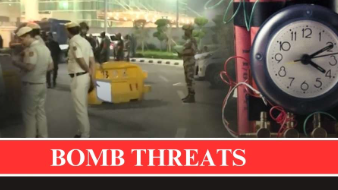

Mumbai: As the sun rose over Mumbai's Chhatrapati Shivaji Maharaj International Airport on a crisp October morning, the usual bustle of India's financial capital was abruptly disrupted. A Akasa Air flight bound for Bengaluru sat isolated on the tarmac, surrounded by bomb squad vehicles and nervous security personnel. Passengers, herded into a cordoned area of the terminal, whispered anxiously among themselves. The cause of the commotion? An anonymous email claiming a bomb was on board.
Hours later, the all-clear was given. No explosives were found. It was, like so many others before it, a hoax.
This scene, once a rarity, has become an unsettling routine across India's airports in recent months. Since January 2023, over two dozen bomb threats have targeted various airlines, including major carriers like IndiGo, Air India, and SpiceJet. Each incident follows a similar pattern: an anonymous threat, immediate security protocols, flight delays, and ultimately, the revelation that it was all a false alarm.
But behind the predictable cycle of threat and all-clear lies a more complex story – one of mounting psychological strain, economic losses, and a cat-and-mouse game between hoaxers and authorities that shows no signs of abating.
"These incidents may seem like mere inconveniences, but their impact runs far deeper," says Dr. Anjali Chhabria, a prominent Mumbai-based psychiatrist. "For passengers, even a false bomb scare can trigger lasting anxiety about air travel. For crew members repeatedly exposed to these situations, it can lead to chronic stress and burnout."
Indeed, a survey conducted by the Indian Commercial Pilots' Association found that 68% of pilots reported increased stress levels due to the recent spate of bomb threats. Flight attendants, often on the front lines of passenger panic, have reported similar concerns.
The economic toll is equally significant. Each bomb threat necessitates a complex and costly response involving multiple agencies. Conservative estimates suggest that a single hoax incident can cost an airline upwards of ₹2 crore (approximately $240,000) in operational losses, not to mention the ripple effects of delayed connecting flights and disrupted travel plans.
"It's death by a thousand cuts," laments aviation analyst Jitender Bhargava. "Indian airlines, already struggling to recover from the pandemic, are now bleeding money due to these malicious pranks."
But who are the individuals behind these hoaxes, and what motivates them?
The Bureau of Civil Aviation Security (BCAS) has identified several distinct profiles. Some are disgruntled ex-employees seeking revenge against airlines. Others are tech-savvy pranksters reveling in the chaos they create. A smaller, more concerning category involves individuals probing for weaknesses in airport security protocols.
In March 2023, authorities arrested a 27-year-old software engineer in Bengaluru for making a series of bomb threats against IndiGo flights. His motive? A perverse desire for social media notoriety.
"The anonymity provided by the internet has made it easier than ever for individuals to cause widespread panic with just a few keystrokes," explains cybersecurity expert Rakshit Tandon. "Many hoaxers believe they can't be traced, but that's far from the truth."
Indeed, law enforcement agencies have been stepping up their game. The Central Industrial Security Force (CISF), responsible for airport security, has established a dedicated cyber cell to trace the origin of threat emails. In collaboration with international partners, they've developed sophisticated tools to unmask those hiding behind proxy servers and virtual private networks (VPNs).
These efforts have yielded results. In 2023, arrests were made in connection with 60% of airline bomb threats, a significant improvement from previous years. Perpetrators now face charges under the stringent Anti-Hijacking Act, which carries a maximum sentence of life imprisonment.
But as authorities adapt, so do the hoaxers. Recent months have seen a shift towards more elaborate schemes, including threats timed to coincide with high-profile events or made through compromised email accounts of unsuspecting individuals.
"It's an ongoing arms race," admits a senior CISF official, speaking on condition of anonymity. "We're always playing catch-up, but we're getting better at anticipating and countering new tactics."
The government has also taken notice. In a recent parliamentary session, Civil Aviation Minister Jyotiraditya Scindia announced plans for a centralized database to track bomb threats and identify patterns. Additionally, a public awareness campaign is in the works to educate travelers about the severe consequences of making false threats.
Yet, some argue that a purely punitive approach may not be enough. Dr. Chhabria suggests that addressing the root causes – whether mental health issues, social alienation, or a misguided sense of power – is crucial to stemming the tide of hoaxes.
"We need to create a society where individuals don't feel the need to resort to such destructive attention-seeking behaviors," she emphasizes.
As India's aviation sector continues to grow, with domestic air traffic reaching record highs in 2023, the stakes couldn't be higher. Each hoax erodes public confidence in air travel and strains an industry vital to the country's economic development.
For now, as another flight takes off from Mumbai, passengers and crew alike share a collective sigh of relief. But in the back of their minds, a nagging question remains: Will the next threat be real?